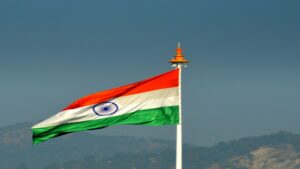Table of Contents
INTRODUCTION
The Flag Code of India is a set of laws, practices, and conventions that apply to the display of the national flag of India. Indian citizens can never fly our national flag at night as raising it in the morning represents strength, and lowering it is a sign of respect and dignity for the flag and the country.
The use, display, and hoisting of the National Flag in the country is guided by an overarching set of instructions called the ‘Flag Code of India 2002’. It brings together all laws, conventions, practices, and education for the display of the National Flag. It governs the display of the National Flag by private, public, and government institutions.

What is the Flag Code of India, 2002?
Flag Code of India, brought on 26th January 2002, had been divided into three parts, it acts as an embracing umbrella that brings together each & every law, convention, practice, and instruction for the use, display, and hoisting of our National Flag. The three parts are:
- The general description of the National Flag.
- It is displayed by members of the public, private organizations, educational institutions, etc.
- It is displayed by the central and state governments and their agencies.
“There shall be no restriction on the display of the National Flag by members of the general public, private organizations, educational institutions, etc., except to the extent provided in the Emblems and Names (Prevention of Improper Use) Act 1950 and the Prevention of Insults to National Honour Act 1971….,” the Flag Code of India 2002 states, before adding a list of do’s and dont’s for the use, display and hoisting of the National Flag.
What amendments have the Centre brought in?
On December 30, the Centre amended the Flag Code of India, 2002 to allow the manufacture and use of machine-made and polyester National Flags. These were not allowed earlier under the Code. As per the amended flag code, National Flags made of hand-spun, hand-woven or machine-made cotton, polyester, wool, silk, and khadi bunting, can also be used.
In another amendment brought on July 20, 2022, the Centre allowed the National Flag to be flown both during the day as well as at night if it is displayed in the open or on the house of a member of the public. Under earlier rules, the Tricolour could only be hoisted between sunrise and sunset.
Why did the Centre amend the Flag Code of India?
The amendments to the flag code came ahead of the launch of the ‘Har Ghar Tiranga’ campaign under which the government is encouraging people to hoist the Tricolour at their homes to mark the 75th Independence Day. The government says it plans to reach out to more than 20 crore homes across India by August 15 through this campaign ahead of the 75th Independence Day of India.
The government believes that amending the flag code will make the National Flag easily available and affordable to the general public.
Why is there controversy over amendments to the Flag Code of India?
The amendment made in December 2021 to allow the use of machine-made and polyster flags has come in from criticism from the Congress, which believes that the Centre has allowed the influx of China-made Indian flags by allowing the import of polyster flags.
Besides the Opposition, some Khadi weavers and activists have also launched a protest against the amendment brought by the Centre. The Karnataka Khadi Gramudyog Samyukta Sangha (KKGSS), for instance, has halted operations in wake of the amendment and called for a nationwide protest against it.
The KKGSS, the unit which spins the fabric used to make the National Flag, says it has recorded a steep fall in the number of orders it has received following the amendment. The facility, which claims to be the only BIS-approved Khadi unit for the material used to make the Tricolour, has also written to the Prime Minister to draw the Centre’s attention to their plight due to the amendment brought by the Centre.
Who can display National Flag on their cars?
The privilege of hoisting the national flag is limited to only a few positions acquired by the country’s people. They are:
- President
- Vice-President
- Governors and Lieutenant Governors
- Heads of Indian Missions Posts
- Prime Minister
- Chief Minister and Cabinet Minister of a State or Union Territory
- Cabinet Ministers, Ministers of State, and Deputy Ministers of the Union
- Speaker of the Lok Sabha,
- Deputy Speaker of LokSabha,
- Deputy Chairman of Rajya Sabha,
- Chairman of Legislative Councils in States,
- Speakers of the Legislative Assemblies in States and
- Union Territories,
- Deputy Chairman of the Legislative Council in the States,
- Deputy Speakers of Legislative Assemblies in States and Union Territories
- Chief Justice of India
- Judges of the Supreme Court
- Chief Justice of High Courts
- Judges of High Courts
